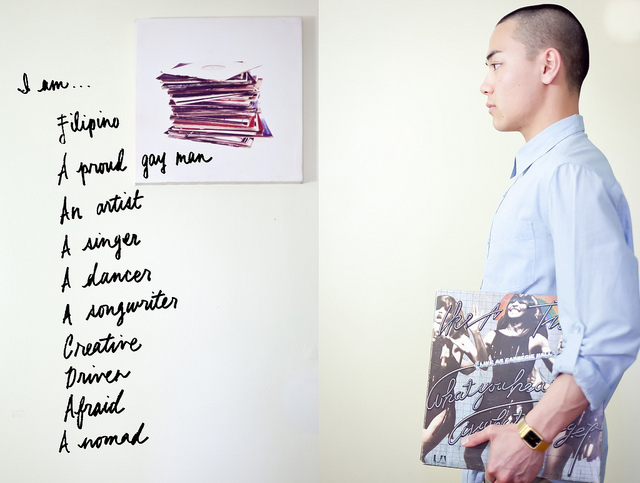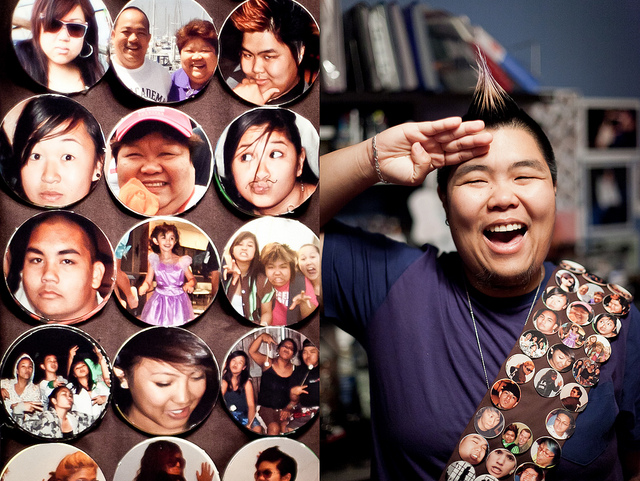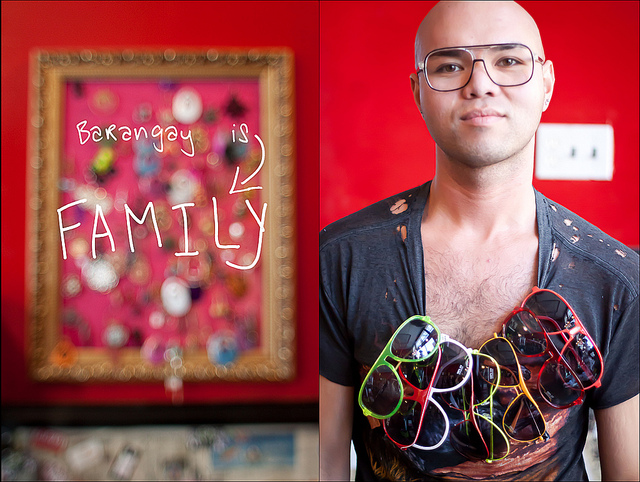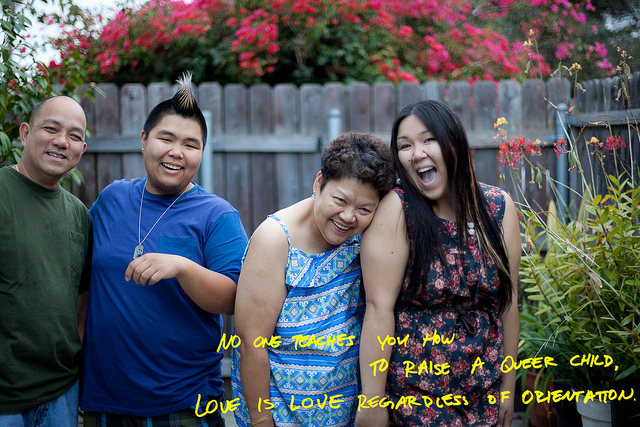0. 1/28/2012 – Art Attack Call for Submissions, by Riese
1. 2/1/2012 – Art Attack Gallery: 100 Queer Woman Artists In Your Face, by The Team
2. 2/3/2012 – Judy Chicago, by Lindsay
3. 2/7/2012 – Gran Fury, by Rachel
4. 2/7/2012 – Diane Arbus, by MJ
5. 2/8/2012 – Laurel Nakadate, by Lemon
6. 2/9/2012 – 10 Websites For Looking At Pictures All Day, by Riese
7. 2/10/2012 – LTTR, by Jessica G.
8. 2/13/2012 – Hide/Seek, by Danielle
9. 2/15/2012 – Spotlight: Simone Meltesen, by Laneia
10. 2/15/2012 – Ivana, by Crystal
11. 2/15/2012 – Gluck, by Jennifer Thompson
12. 2/16/2012 – Jean-Michel Basquiat, by Gabrielle
13. 2/20/2012 – Yoko Ono, by Carmen
14. 2/20/2012 – Zanele Muholi, by Jamie
15. 2/20/2012 – The Malaya Project, by Whitney
![]()
I have difficult parents — they’re immigrants and I’m first-generation, American-born. They are also traditional and very homophobic, and that has not made my life easy. I knew in my single digits that I was gay, but I had nowhere to go with that knowledge, and no one to talk to about it. I looked online for people to connect to, but this was pre-YouTube, so it took half a day on our dial-up connection to download 30-second clips from The L Word or Boys Don’t Cry. I looked for queer people on Xanga to talk to, but that community wasn’t the kind I needed. What I really needed was someone to talk to, and someone to look up to, who understood what I was going through — race-related issues and all.
Gregory Pacificar and Deney Tuazon also had this problem. It’s strangely comforting knowing that we experienced the same isolation as queer people of color, and that we all looked for the same difficult-to-find queer community. Pacificar and Tuazon similarly went to the Internet to look for queer Filipinos to talk to, and they weren’t able to find that community, either. As Pacificar says, “There was a lack of our visibility but there wasn’t a lack of porn sites.”
Pacificar and Tuazon started talking to people involved with Barangay LA, a not-for-profit organization that supports the LGBTQ Filipino/a-American community in Los Angeles, asking other queer Filipinos/as what their coming-out stories were. “A lot of them talked about their family, being afraid to tell others, and soon a story started to develop,” Pacificar says. “We started to see commonalities in their stories, and in our own as well.”
Pacificar explained that the people they talked to also described a desire to find others who “were just like them” when they were first coming to terms with their sexualities. Other queer Filipinos/as found chat rooms to connect with people (“AOL was big when we were coming out,” Tuazon adds), but the lack of visibility still remained. “They [still] couldn’t find positive images of other LGBTQA Filipinos/as,” Pacificar says.
Out of this absence came The Malaya Project.
According to Pacificar, The Malaya Project, in collaboration with Barangay LA, collects “written and photographic narratives of the lives of proud LGBTQA Filipinos and Filipinas.” The word “Malaya” means “to be free,” and these images are truly liberating — how often do you see queer people of color feeling proud of themselves, doing well for themselves, and fighting for themselves?
When I firstsaw the images, I was struck at how infrequently I’ve seen images like that of queer Filipina artist Allison Santos (of That’s What She Said) smiling and laughing with her family inside of a modest backyard LA garden. Or musician and singer Jonathan Atanaya Ilano standing in his home space, holding a vinyl copy of Ike and Tina Turner’s What You Hear Is What You Get. Or Patrick Santa Ana, a designer, standing proudly in the rooms of the accessory store he opened in Long Beach, CA, ELEV8. Or Maria Carmen Hinayon, a pageant-winner and student who identifies as “transgender and empowered,” walking proudly through her school’s campus.
“For me, [The Malaya Project] was a chance to give someone an opportunity to look up to someone when they’re a teen. A chance I didn’t have,” Pacificar says. “I was one of those gay boys looking for a role model, looking for guidance.”
The images are both powerful and empowering. Not only do they present the individuals in their personal space, but the photos capture the details of their subjects’ lives, from the contents of Hinayon’s purse (lip gloss, perfume, brushes, sunglasses and a makeup compact) to the array of shoes (slip-ons and lace-ups covered in everything from plaid to black leather) lined up in a wall in Ilano’s home. It’s these details that create a complete and complex picture of identity. Pacificar, a filmmaker, and Tuazon, a photographer, clearly treat their subjects with care and compassion.
“Their story is what starts the creative process,” Tuazon says. “We always ask our subjects what it is that they want to share to others.”
Each of the profiles highlights something particular to each of the individuals — in Ilano’s case, this particular spark “was music and it was natural to highlight that side of him,” Tuazon adds. Ilano’s profile is one of the two that includes video, in which he belts out a song he wrote himself “when he was trying to figure out who he was as a gay teen,” says Pacificar. “When he showed us his lyrics we just had to capture him singing the very song he wrote to get through his teen years.”
The lyrics are heartfelt and emotional: “Year after year / growing into this fear / Kept me hoping / I’d make it to the other side / Year after year / drowned myself in my tears / but now I’m here / on the other side.” It’s the kind of thing a queer kid needs to hear, whether she’s a person of color or not.
[yframe url=’https://www.youtube.com/watch?v=2IzhCG2JAvY’]
Hinayon’s message is similar. In one image, Hinayon walks stoically through campus, and in her handwriting she writes about being “bullied, harassed and discriminated [against] but I never gave up.” In another image, she stands in the middle of a crowded hall. Next to this image, she has written “Education is the key to liberation.”
“It was painful to hear when Carmen shared her experience being bullied, but I was deeply touched when she said ‘I want other transgenders to know they can make it. They can get an education. They can achieve all their goals.'” Pacificar says.
Santos’s profile sends a message about family that is bittersweet to look at, at least for me: Her images are firmly grounded in home and family, and the acceptance she feels from her parents is in every photograph. “When we met her, she also started telling us about her family. And how they were so supportive of her identity as a queer Filipina,” Pacificar says.
The images convey this so well: Many of the photos of Santos include her parents and her sister, from the jumping shot of her family suspended in mid-air, smiling, to a photo of her sitting next to her mother. Next to the photo is written, in Santos’s handwriting: “I wanted to wear shorts and pants, mom wanted dresses. We fought for years. One day I came home and my mom said she bought me two pairs of boxers. Our war ended.”
The love and support in the family was palpable when Pacificar and Tuazon entered Santos’s house for the photo and video shoot. “The first step we took inside their home, you can read that support from wall to wall. Diplomas, awards and medals next to their family photos,” Tuazon says.
These images are powerful and necessary — images of family, survival and support from the queer Filipino/a community are important but often difficult to find. But it’s the story that Santos, Ilano, Hinayon and Ana wish to share that drives the project and its message. “All our participants have … faced struggles [that aren’t] uncommon in our community. But what makes them all great role models is their journey to overcome obstacles,” Pacificar says.
These are the images I needed growing up, and the images that Pacificar and Tuazon needed, too. The Malaya Project takes our search for community, especially as LGBTQA people of color, and presents it to us: The role models we have and maybe wish we had.







Such a wonderful project. I wish I had something like this growing up. I was always afraid of coming out to my mother, but she is very accepting of me. It’s nice to be able to relate to coming out stories like Allison Santos’s.
FUCK YEAH. so rad and relevant.
thanks for this whitney!
this is so cool, whitney
Thanks again Whitney!
This.
Yeah, this.
This is so beautiful, both in concept and because it is very enjoyable to look at! Everything about this makes me happy. Thank you, Whitney!
Just.Lovely.
Bebot bebot
THANK YOU. as a filipino-american queer, i am so glad to see and hear and read about this. just what we need! icansofuckingrelate.
this is so fucking beautiful it brings tears to my eyes and makes my heart swell!!!
Queer Asian/Americans FTW! I’m so happy you read the article — it was one of the more difficult articles for me to write, and I’m glad I did it. :)
“There was a lack of our visibility but there wasn’t a lack of porn sites.”
word. those aren’t the kinds of fucks awesome queer POCs want anyway…
whitney, i don’t know you but i love you. thanks for this entire piece.
I thought that quote was so relevant. When I was in high school I googled “Asian lesbian / gay” and “Asian lesbian / gay groups” to see if I could find people to talk to, and all I found were pages of porn sites. It’s pretty disheartening.
Thanks for reading — knowing that people are reading stuff like this is so important to me. <3
Love love love the second picture. Amazing article, Whitney!
A wow article Whitney ! So many queer can identify themselves and their family values and backgroiund in these stories.
Reminds me of the excellent indie film “Rome and Juliet”. Such a powerful and strong story but rejected by the filipino society.
Thank you! I’ll be sure to check out “Rome and Juliet”!
Great article. Thanks for writing about this!
I seriously needed this! I was just wishing I knew more about other queer Filipinos~!
http://ragingsoundofcalm.tumblr.com/post/18252832784/real-talk-on-being-a-feminist-being-queer-being
real talk. on being a feminist, being queer, being femme, and being filipina.
Before I say anything, I want to put on the table my privileges. That is; I am cis-gendered (not trans), able-bodied, housed, employed, English fluent, and has status. It’s important to me to name these things when doing anti-oppression work because it is through these lens (with many other lenses) i am able to gain perspective and experience. It is also important for me to check my privileges in order for me to be a much more sincere and effective ally.
I am not an academic. I am my own author of my experiences, and therefore that is the place where i will mostly speak from. When i look at how feminism is defined, and how it’s evolving, there are two main things that stand out for me. 1. The strive for gender equality and 2. It’s intersectionalities with my racialized identity.
Yes i identify as a feminist. And when you say this, people start formulating in their heads their own definitions of what a feminist looks like, and how a feminist must act. That is problematic, for we have our own individual definitions of feminism – and how i define my feminist identity may not be relevant or applicable to someone else’s definition.
Feminism is still relevant because we do not have gender equality. This may sound bold but it’s my truth. I want to make clear that when i speak of gender – i speak of all genders. I believe to be a feminist – one must walk away from the gender binary of man and woman only, or the limiting definitions of what it is to be a man and be a woman. Yes it’s worth looking at male privilege – but again that is also the same system that invisibilizes and silences genders that cannot be comfortably placed in the binary. To be a feminist – one must align themselves against heterosexism. What does that even mean? To be a feminist, is to also acknowledge the realness, the voices and the presence of queer and trans people. It is important not to equate gender identity and gender expression and sexual orientation as synonymous entities. If you are putting me in a box of what my womanhood should look like – that i should be wearing a skirt, have long hair, have a boyfriend – then that is also oppressive, and that to me, is not feminism.
We all lie in a spectrum of genders and it’s many expressions – for me my expression is femme – it’s taken a lot of work, and more work, to reconcile and negotiate this identity as a self-chosen one. I was brought up to be a girl, had resources for being a “girl”, wore “girly” clothes, and thought it just made sense to be with a “boy”. I struggle with this “femme” identity that was pushed onto me by my parents, the media, society, and my relationships.
Coming out as a queer person – though this process was recent, in retrospect i had many queer experiences growing up. There is a lot of shame being femme and being queer. And i found this as well as i started identifying as queer, and started searching for queer “feminist” spaces. I felt tension about my femmeness in the queer community. I felt invisible as a queer person – and if this doesn’t make sense to you, i felt invisible because my gender identiy and how i express it – has been socially contextualized as straight. It is so ingrained. The same system that labels me as straight, also labels my gender as one that has no voice, one that has no capacity for intelligence, one that is only emotional, one that is meek. And guess what – i am so fierce and intelligent and emotional and my voice is pretty loud. So there is a disconnect for me. Femmephobia is so real in queer feminist communities. So to go away from my straight identity, to being queer and hoping for liberation and validation – i learned very early that i have to start defining my experiences under my terms – because people come with so much of their colonized and socialized minds, that they cannot even phantom a person looking like me to be queer. And if people cannot even understand this, how can they even begin to understand the deep layers and complexities of being genderqueer and trans identified. Transphobia and homophobia is such a part of our culture and this is why i do the work that i do, tirelessly. The political is personal – they are not separate fights.
And as audre lorde says – “I am a Black Feminist. I mean I recognize that my power as well as my primary oppressions come as a result of my blackness as well as my womaness, and therefore my struggles on both of these fronts are inseparable.” Praise the [audre] LORDE. My filipinoness and my womanness – are inseperable. To add another layer to my queer identity and my gender, let’s add in equal parts, my racialized and visible identity. It’s a perfect recipe for oppression and subjugation. Once, someone assumed that because I am an immigrant and Filipino, i must have come here as a “nanny.” Then there are those that eroticize and fetishize me as being a mail order bride – or because i am a nurse, i must wear sexy outfits and play the sexy night nurse to my imaginary cis-male boyfriend. I’m not saying there is anything wrong with sexual role plays – but if you reduce me as just a sex toy, reduce me to the generalizations of Filipinos, that i can only exceed in the highly gendered caregiving industry, or that i cannot have status because we Filipinos can only be migrant and temporary workers – then that is highly racist. I have learned that doing anti-racism work has been an emotionally heavy undertaking for me. It requires of me to reflect and explore my own Filipino identity and my stories of immigration, racialization and my otherness as outcomes of my migration. I feel that i’ve avoided this because there is a deep well of pain i have not yet explored or faced . In the 10 years i have been in Canada, my parents who are now in their 50’s have struggled with so much racism in their lives and in their work. To watch my parents lose their fire and be eaten alive by their racist workplaces, their abusive white bosses, being overlooked for promotion year after year, having very limited work opportunities as older non-english fluent immigrants, every time i had to watch someone yell at them because they could not understand their English amidst their accent – i am enraged and deeply hurt. And this rage, this rage is what they do not understand. White privilege and white systems do not understand our rage as racialized people. Because they never had to experience it. Racism happens for me very differently than my parents. It is usually intertwined with my gender – i find that it is tied a lot into how i’m sexualized and racialized – and they happen simultaneously, and concurrently.
Because i am empowered, i was able to navigate and find community that was safe for me as a Filipino person, but at the same time, i did not have a Filipino community that also embraced my radical gender politics. I found Filipino spaces in Toronto still very heteronormative. And i find myself displaced and isolated wherever i turn – in queer spaces, i found many amazing people of colour, but there were very few Filipino people; in Filipino spaces, i did not find a lot of queer and trans visibility and explicit inclusion, and i find this problematic. And so, as i sit with all these reflections and understanding my needs for liberation and validation, i am achingly longing for a space that embraced both my queerness and filipinoness.
charm torres
Yeah ! I love it !
That last photo? I got all choked up. Hang on, I need a moment.